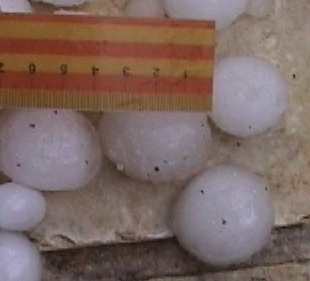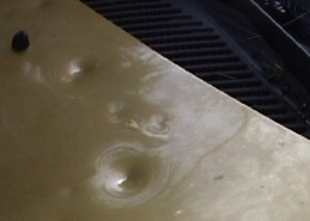Jumbo Deluxe Hail
Blog topic:

4 cm in diameter hail. Fell over Mevasseret Zion (western suburb of Jerusalem) on Oct 29, 2004. In nearby Kibbutz Tzuba, hailstones measuring 5 cm in diameter were measured. 3 car windshields were shattered.

Dents in the sheet metal of a Renault Clio, caused by 5 cm hail.
The hail pictures were taken in Mevasseret, a few miles north east of Tzuba. In Mevasseret, the stones were "only" 4 cms in diameters or less. Doesn't sound like much, but it does make a significant difference in the energy of the hail stones.Here is a physicists take on it.
Speed of Falling Hail and the necessary updraft in the thunderstorm
The terminal speed of a falling hailstone is obtained by finding the equilibrium between the gravitational pull downwards and the air drag upwards.If the hailstone has a radius r then the gravitational force down is given by:
$ \displaystyle F_{grav} = {4 \pi \over 3} \rho_{ice} r^3 g $
The air drag upwards is given by (e.g., see here):
$ \displaystyle F_{drag} = {1 \over 2} C_d \rho_{air} v^2 A = {\pi \over 2} C_d \rho_{air} v^2 r^2 $
Where the drag coefficient Cd is about 0.5 for hailstones. By equating the forces, we find the terminal velocity:
$ \displaystyle F_{grav} = F_{drag} ~~~\Rightarrow ~~~ v_{term} = \sqrt{ 8 g \rho_{ice} r \over 3 C_d \rho_{air}} $
Thus, a 5 cm in diameter hail reaches a terminal velocity of:
$ \displaystyle v_{term}(r=2.5cm)~ \approx~ 30.5~ m/s ~\approx~ 110 ~km/s ~\approx~ 70~ mi/hr $
To obtain such a large hail stone, we need updrafts which are at least that strong! Energy in the hailstones
The kinetic energy in the hailstone will be:
$ \displaystyle E_{kin} = {1 \over 2} m v_{term}^2 = {16 \pi g \rho_{ice}^2 \over 9 C_d \rho_{air}} r^4 $
For a 5 cm in diameter hailstone, we obtain about 2100 J. This a little bit more than the energy of a 5.56 bullet (used in M-16's for example). Because of the high dependency in radius, the 5 cm hailstones have an energy which is about (5/4)4 ~ 2.5 times larger than the 4 cm in diameter hail in the picture, even though they are moving only (5/4)1/2 ~ 1.11 times faster.
For comparison, the largest hailstone ever measured had a radius of about 5 inches. Thus, it was moving at about 155 mi/hr and had about 40 times the energy of the hailstones which shattered the wind shields in this middle eastern storm.

Comments (2)
jesus christ! this can kill someone!
I remember a similar Storm further south in Beersheva, at around 97...
The city suffered expensive damages because of the golf-ball hailstones...
Almost every one in the city had to replace their window shutters and solar heating panels... I do not think anyone was struck badly by a hailstone